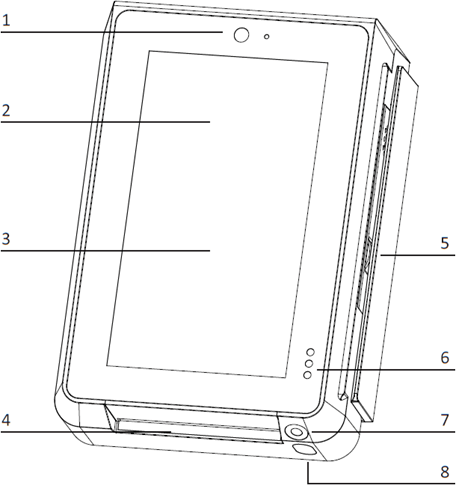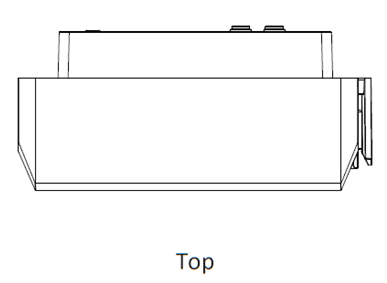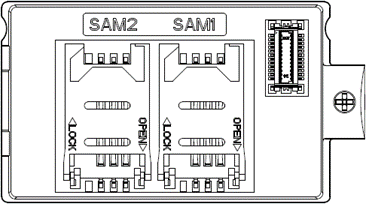| Name | Qty. |
| IM30 Unattended Payment Terminal | 1 |
| M4 Nuts | 4 |
| M4 Screws | 4 |
| Mounting Bracket | 1 |
PRODUCT DESCRIPTION
Front View

- Front Facing Camera
- Contactless Card Reader Interface
- LCD Touchscreen
- Smart Card Reader
- Magnetic Strip Card Reader
- Proximity and Light Detector
- Code Scanning Camera
- Camera Lighting
Back View

- Anti-removal Switches
- 4G Antenna SMA Connector (Optional)
- GPS Antenna SMA Connector (Optional)
- 4G Module & SIM Card Slot
- RS232-B (RJ45)
- RS232-A (RJ45)
- Ethernet Port (RJ45)
- Auxiliary Port (Mic + Speaker)
- Digital IO Port
- MDB Master Port
- USB Type-A Port
- USB Type-C Port
- Service Button
- Reset Button
- HDMI Port
- Status Indicator LED
- MDB Slave Port
Left View

Right View

Top View

Bottom View

INSTALLATION
4G Module SIM and SAM Cards



Certain configurations of the IM30 will have a 4G network module, in these configurations you can install a SIM card. Unscrew the 4G network module and remove it to reveal the SIM card slot on the bottom of the module. Push the card into the slot with the contacts facing up and the clipped corner of the card facing towards the module. Certain configurations of the IM30 will have physical SAM card slots available, you may install SAM cards in a similar manner to the SIM cards (make sure to use the appropriate card slots as indicated in the figure above.
SAM Cards

The IM30 has two dedicated SAM card slots, they can be accessed on the main body of the IM30 after the 4G network module (or the empty back cover) is removed. Open the card mount by sliding the card mount in the “OPEN” direction indicated on the mount, then insert a SAM card with the contacts facing the IM30 and the clipper corner oriented to the upper left. Lock the card mount by pressing it to the contacts and sliding it in the “LOCK” direction indicated on the card mount.
Note: Do not power on the IM30 while installing or removing SIM or SAM cards. To reassemble the device, slide the two plastic tabs on the left of the module into the corresponding slots on the main body of the IM30, then insert the 4G network board into the board to board connector. Finally, locked the module in place using a screwdriver.
Device Dimensions

Device Installation

- Measure the thickness of the mounting plate, this is used later in step 4.
- The back face of the mounting plate should have four stud bolts corresponding to the mounting points located on mounting bracket. Slide the mounting bracket into place with the orientation shown in figure 9 and then fix it in place with four M4 nuts.
- Slide the IM30 unit into the mounting plate with the orientation shown in figure 9. The back portion of the device should rest securely inside the mounting bracket.
- If the mounting plate is ≤ 4mm thick, apply a torque of 0.6 ~ 0.8 Nm to the four M4 screws included with your IM30 unit to secure the IM30 to the mounting bracket. If the mounting plate is more than 4mm thick, obtain M4 screws with the following thread length and use them instead: (mounting plate thickness + 10mm) ≤ thread length ≤ (mounting plate thickness + 14mm)
Note: The IM30 is intended to be installed 90° vertically to a maximum of 60° tilt from the vertical incline surface, ingress protection rate at IP65 is not guaranteed if the mounting surface deviates from this. Please refer to the picture below.

Instructions
Power on: Plug the IM30 into an appropriate power source 24 VDC via the JVMA port, the digital IO port, or the RS232-B RJ45 port.
Power off: Disconnect the IM30 from the power source it is connected to.
Contactless Transactions
When the device is ready to accept a contactless transaction, the contactless icon should appear on screen. Orient the card or NFC device parallel to the screen and then hold it at a distance of 4 cm or less directly above the contactless icon.
Code Scanner Transactions
When the device indicates on screen that it is ready to scan a 1D or 2D code, orient the code parallel to the code scanning camera and then place it directly in front of the camera.
Environmental Conditions
Storage Temperature: -30°C ~ 70°C (-22°F ~ 158°F)
Operating Temperature: -20°C ~ 70°C (-3°F ~ 158°F)
Relative Humidity: 5% ~ 95% (non-condensing)
Maintenance and Usage
- If any cables become damaged, seek a replacement.
- Do not insert unknown materials into any port on the IM30, this may cause serious damage to the device.
- If repairs are required, please contact a professional technician instead of attempting them on your own.
- The IM30 contains tamper-proofing features; these circuits will trigger if the device is disassembled, at which point it will have to be rearmed before the device is ready to resume operation.
- The IM30 is designed for outdoor use; however, during normal use its surface should still be keep clear of dirt and possible liquid contaminants.
- While the IM30 is designed to resist ingress of dust and liquids, it is not designed to resist pressurized liquids such as water hoses. Keep the back of the device away from dust and liquids as much as possible.
- Make sure the various cables connect to provide the appropriate voltages at the proper pins.
Compliance Statements
FCC COMPLIANCE STATEMENT
This device complies with Part 15 of the FCC Rules. Operation is subject to the following two conditions:
1) this device may not cause harmful interference, and
2) this device must accept any interference received, including interference that may cause undesired operation.
Changes or modifications not expressly approved by the party responsible for compliance could void the user’s authority to operate the equipment.
Note
This equipment has been tested and found to comply with the limits for a Class B digital device, pursuant to Part 15 of the FCC Rules. These limits are designed to provide reasonable protection against harmful interference in a residential installation.
This equipment generates, uses and can radiate radio frequency energy and, if not installed and used in accordance with the instructions, may cause harmful interference to radio communications.
However, there is no guarantee that interference will not occur in a particular installation. If this equipment does cause harmful interference to radio or television reception, which can be determined by turning the equipment off and on, the user is encouraged to try to correct the interference by one of the following measures:
• Reorient or relocate the receiving antenna.
• Increase the separation between the equipment and receiver.
• Connect the equipment into an outlet on a circuit different from that to which the receiver is connected.
• Consult the dealer or an experienced radio/TV technician for help.
Note
Any changes or modifications not expressly approved by the manufacturer could void the user’s authority to operate this equipment.
Radiation Exposure
This device complies with FCC radiation exposure limits for general environments.
INDUSTRY CANADA STATEMENT
This device contains licence-exempt transmitter(s)/receiver(s) that comply with Innovation, Science and Economic Development Canada’s licence-exempt RSS(s). Operation is subject to the following two conditions:
1) this device may not cause interference, and
2) this device must accept any interference, including interference that may cause undesired operation of the device.
Le présent appareil est conforme aux CNR d’Industrie Canada applicables aux appareils radio exempts de licence. L’exploitation est autorisée aux deux conditions suivantes:
1) l’appareil ne doit pas produire de brouillage, et
2) l’utilisateur de l’appareil doit accepter tout brouillage radioélectrique subi, même si le brouillage est susceptible d’en compromettre le fonctionnement.
The user manual for LE-LAN devices shall contain instructions related to the restrictions mentioned in the above sections, namely that:
i. the device for operation in the band 5150–5250 MHz is only for indoor use to reduce the potential for harmful interference to co-channel mobile satellite systems;
i. le dispositif utilisé dans la bande 5150-5250 MHz est réservé à une utilisation en intérieur afin de réduire le risque de brouillage préjudiciable aux systèmes mobiles par satellite dans le même canal;
This device and its antenna(s) must not be co-located or operating in conjunction with any other antenna or transmitter, except tested built-in radios.
Cet appareil et son antenne ne doivent pas être situés ou fonctionner en conjonction avec une autre antenne ou un autre émetteur, exception faites des radios intégrées qui ont été testées.
The Country Code Selection feature is disabled for products marketed in the US/Canada.
La fonction de sélection de l’indicatif du pays est désactivée pour les produits commercialisés aux États-Unis et au Canada.
Radiation Exposure Statement
This equipment complies with IC radiation exposure limits set forth for an uncontrolled environment. This equipment should be installed and operated with minimum distance 20cm between the radiator & your body.
Déclaration d’exposition aux radiations
Cet équipement est conforme aux limites d’exposition aux rayonnements IC établies pour un environnement non contrôlé. Cet équipement doit être installé et utilisé avec un minimum de 20 cm de distance entre la source de rayonnement et votre corps.
Trademark Recognition

Although PAX Computer Technology (Shenzhen) Co., Ltd. strives to maintain the accuracy of the information presented in this document, it reserves the right to change product specifications without prior notification and does not guarantee that the material presented herein will accurately reflect the set up, installation, or use of PAX products.